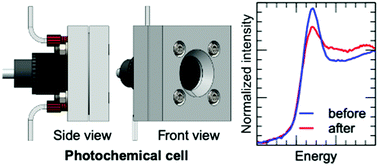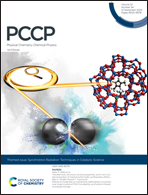Development of photochemical and electrochemical cells for operando X-ray absorption spectroscopy during photocatalytic and electrocatalytic reactions†
Abstract
Photochemical and electrochemical reactions are highly relevant processes for (i) transforming chemicals (e.g. photoreduction of isopropanol to acetone, electrochemical hydrogenation of benzaldehyde to benzyl alcohol, etc.), and (ii) sustainable energy production (e.g. photoreduction of CO2 to methanol, electrocatalytic H2 evolution reaction). It is therefore of importance to monitor the structural changes and to understand the properties of active sites under photocatalytic and electrocatalytic reaction conditions. Operando X-ray absorption spectroscopy (XAS) provides the means to investigate the nature of active sites under realistic reaction conditions. In this contribution, we describe the successful development of photochemical and electrochemical cells for operando XAS measurements during photocatalytic and electrocatalytic reactions. We have used the operando photochemical cell to monitor the formation of Pt nanoparticles on graphitic carbon nitride nanosheets (g-C3N4-ns) via photodeposition under visible light illumination and observed the formation of highly dispersed Pt nanoparticles with an estimated size of ∼2.5 nm and >60% dispersion. We have also tested this cell to follow the oxidation state of Pt in Pt/TiO2 and Pt/g-C3N4-ns during H2 evolution reaction (HER). We observed that Pt predominantly existed as metallic (reduced) Pt0 species under HER conditions, and that PtOx species were partially reduced from PtIV to Pt0 upon illumination with UV or visible light. The rates of H2 evolution obtained in the photochemical cell (12.1 mmol g−1 h−1 on Pt/TiO2 and 1.01 mmol g−1 h−1 on Pt/g-C3N4-ns) were comparable to that obtained in a standard top-irradiated photoreactor (16.6 mmol g−1 h−1 on Pt/TiO2 and 1.76 mmol g−1 h−1 on Pt/g-C3N4-ns). The operando electrochemical cell was successfully tested to monitor the changes in the structure and oxidation state of Pd in Pd/C electrocatalyst during electrocatalytic hydrogenation (ECH) of benzaldehyde. It was demonstrated that Pd in Pd/C was present in a partially reduced state (∼80% Pd0 and ∼20% PdII) and Pd nanoparticles did not degrade upon the application of an external potential under ECH reaction conditions.

- This article is part of the themed collection: Synchrotron Radiation Techniques in Catalytic Science


 Please wait while we load your content...
Please wait while we load your content...